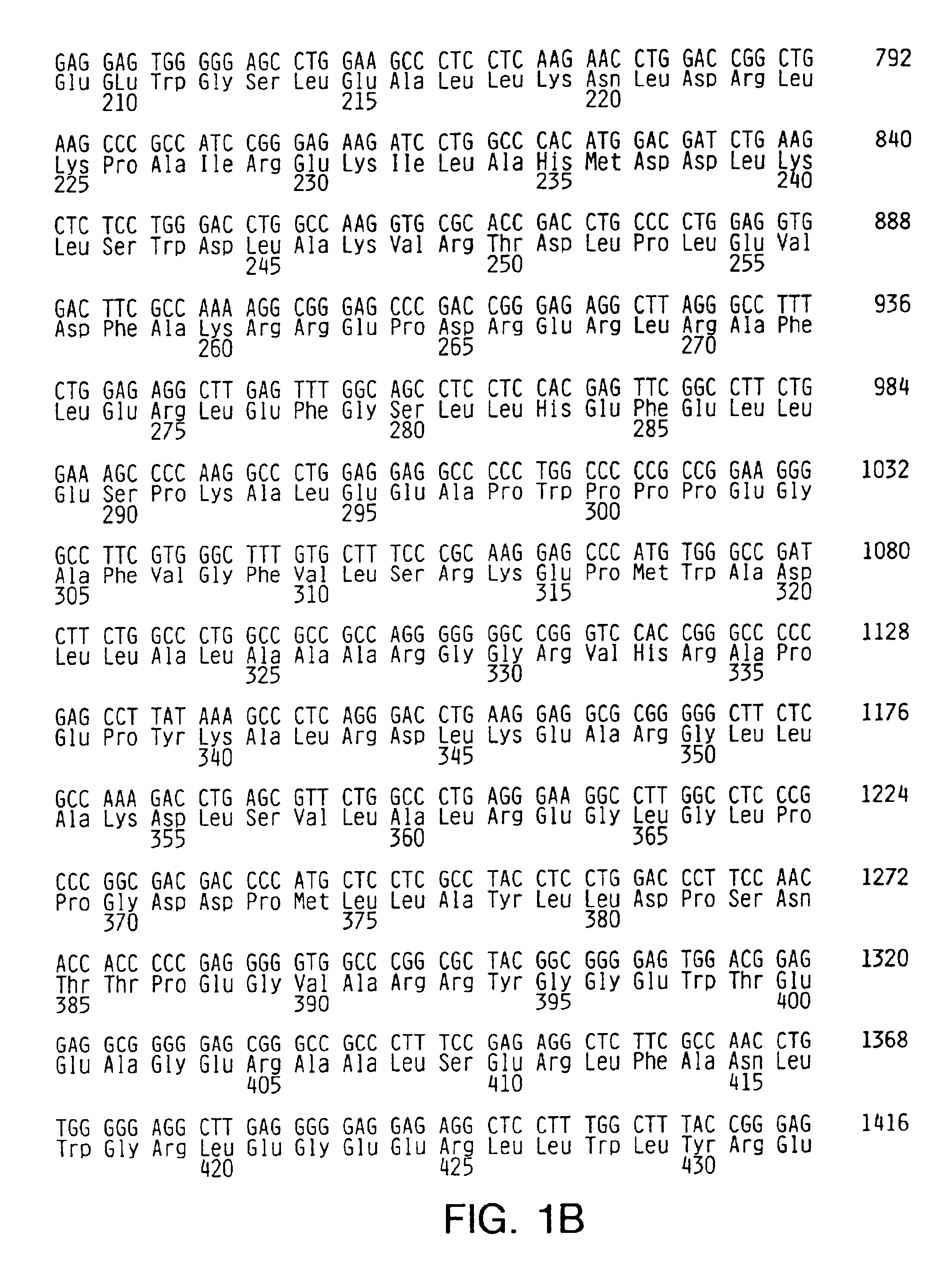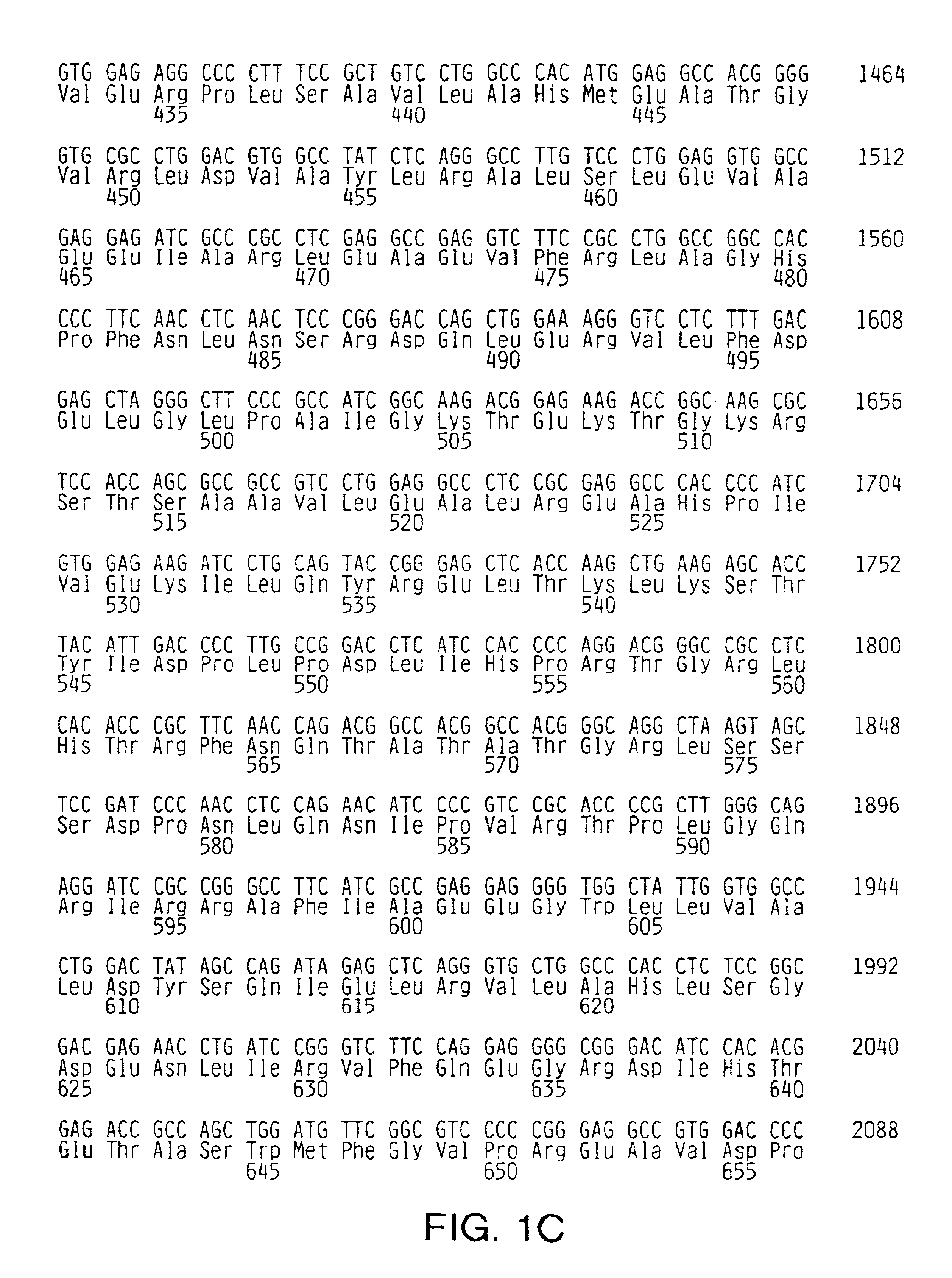Thermostable polymerases having altered fidelity and methods of identifying and using same
a polymerase and fidelity technology, applied in the field of thermostable polymerases, can solve the problems of difficult to predict the effect of introducing an amino acid mutation into the sequence of a protein, limited ability to isolate dna for study, and inability to predict the effect of specific amino acid residue mutations on the function of that protein, etc., to achieve high-fidelity polymerases, altered fidelity, and altered fidelity
- Summary
- Abstract
- Description
- Claims
- Application Information
AI Technical Summary
Benefits of technology
Problems solved by technology
Method used
Image
Examples
example i
Random Sequence Mutagenesis and Identification of Active Taq DNA Polymerase Mutants
[0074]This example demonstrates random nucleotide sequence mutagenesis of a polymerase target sequence and identification of active polymerase mutants.
[0075]Random sequence mutagenesis was used to introduce mutations into the O-helix of Taq DNA polymerase. Briefly, the Taq DNA polymerase I gene was obtained from the bacterial chromosome by cloning in pKK223-3 (Pharmacia Biotech, Piscataway, N.J.). A 3.2-kb fragment containing the Taq DNA polymerase I gene, including the 5′-3′ exonuclease domain and the tac promoter region, was further transferred into the SalI site of pHSG576 (pTacTaq). The Taq DNA polymerase I gene was sequenced to confirm wild type sequence except for the lack of the N-terminal three amino acids.
[0076]A vector containing a nonfunctional insert within the Taq DNA polymerase I gene was constructed and subsequently replaced with an oligonucleotide containing the random sequence to avoi...
example ii
Identification of Taq DNA Polymerase I Mutants and Immutable or Nearly Immutable Amino Acid Residues
[0084]This example describes the identification Taq DNA polymerase I mutants generated by a randomized library and the identification of immutable or nearly immutable amino acid residues.
[0085]The active Taq DNA polymerase I mutants identified by the screen described in Example I were further characterized. The entire random nucleotide-containing insert was sequenced from a total of 234 plasmids obtained at 37° C. (positively selected), 16 plasmids obtained at 30° C. (nonselected) and 29 plasmids obtained at 30° C., which failed to grow at 37° C. (negatively selected). All substitutions were in the randomized nucleotides except for 12 clones.
[0086]Among the 230 positive plasmids, 168 contained silent mutations in one or more codons. At the amino acid level, 106 encoded the wild type residue and 124 encoded substitutions, in accord with the expected distribution in the plasmid populati...
example iii
Determination of the Fidelity of Active Taq DNA Polymerase I Mutants
[0093]This example describes methods of determining the fidelity of active Taq DNA polymerase I mutants. Two types of assays are useful for determining the fidelity of active polymerase mutants, a primer extension assay and a forward mutation assay.
[0094]Crude extracts were used to determine the fidelity of polymerase mutants. A single colony of E. coli DH5α (F−, φ80dlacZΔM15, Δ(lacZYA-argF)U169, deoR, recA1, endA1, phoA, hsdR17(rk−mk+), supE44, λ−, thi-1, gyrA96, relA1) carrying wild type or mutant Taq DNA polymerase I was inoculated into 40 ml of 2×YT (16 g / liter tryptone, 10 g / liter yeast extract, 5 g / liter NaCl, pH 7.3) containing 30 mg / liter chloramphenicol. After incubation at 37° C. overnight with vigorous shaking, an equal amount of fresh medium with 0.5 mM IPTG was added, and incubation was continued for 4 h. Cells were harvested, washed once with TE buffer (10 mM Tris-HCl, pH 8.0, 1 mM EDTA) and suspended ...
PUM
| Property | Measurement | Unit |
|---|---|---|
| temperatures | aaaaa | aaaaa |
| temperatures | aaaaa | aaaaa |
| temperatures | aaaaa | aaaaa |
Abstract
Description
Claims
Application Information
 Login to View More
Login to View More - R&D
- Intellectual Property
- Life Sciences
- Materials
- Tech Scout
- Unparalleled Data Quality
- Higher Quality Content
- 60% Fewer Hallucinations
Browse by: Latest US Patents, China's latest patents, Technical Efficacy Thesaurus, Application Domain, Technology Topic, Popular Technical Reports.
© 2025 PatSnap. All rights reserved.Legal|Privacy policy|Modern Slavery Act Transparency Statement|Sitemap|About US| Contact US: help@patsnap.com



